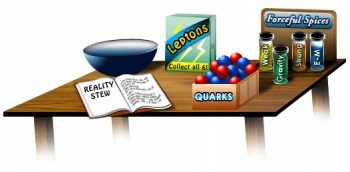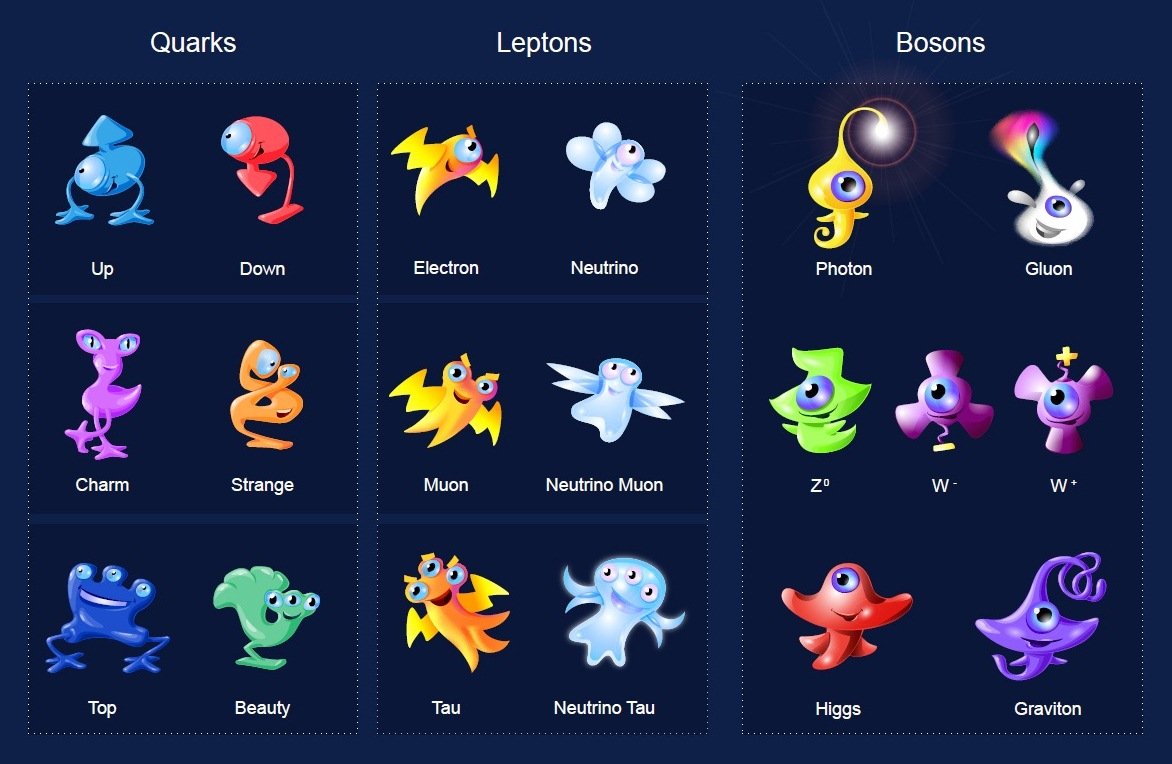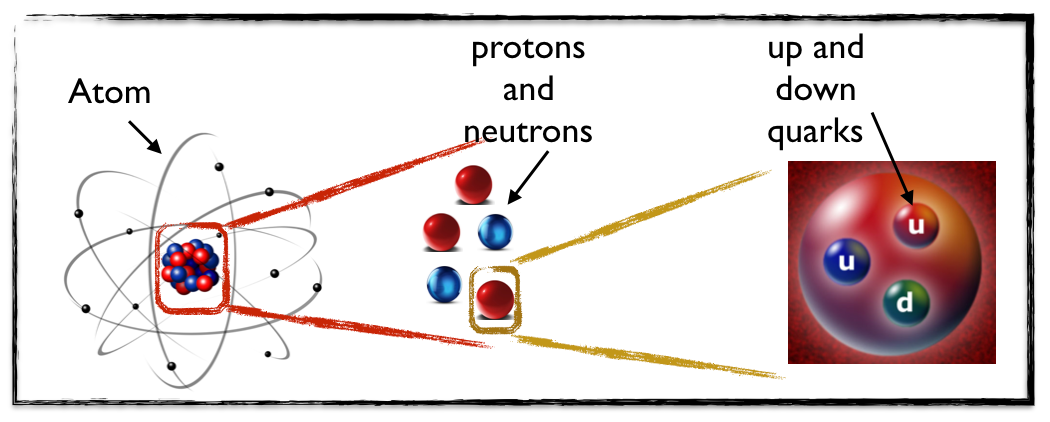More and more, people are telling me that particle physics is today introduced at the high school level. For instance, this is the case in some high schools in France. I have also learned recently that this was the case in Norway too (@fredrikaa may know better about it).
I am sure that this is also true for other countries (please let me know in the comments to this post).

[image credits: The Particle Adventure]
Particle physics relies on tough concepts, like quantum mechanics, special relativity, field theories and gauge theories, that are on top of being complicated, all mixed together.
It is thus not too easy to share the information with people that have not any high-level mathematics background, without paying the price of oversimplifying and introducing errors. Simplifications are fine but one must keep the description correct.
The theory describing how the elementary particles work is called the Standard Model of particle physics. The four (theoretical) ingredients underlying its construction have been named above, and can be gathered into two notions:
- quantum field theory that is the merging of field theory, quantum mechanics and relativity;
- gauge theories that explain how to relate symmetries to interactions, or forces, and use that for their modeling.
In this post, I will discuss quantum fields, what they are, and how to connect them to particles. In a second post that I may write later (somehow… I am not very good in keeping the schedule :p), I will focus on the second concept of gauge symmetries.
QUANTUM FIELD THEORY
Particle physics theories rely on quantum field theories. This means that the basic quantity which everything will be built upon, is a quantum field. One good way to explain what a quantum field is is to connect it to the notion of particles.
But we must be careful, a quantum field is not a particle. What do you think a particle is? Please answer the question for yourself before reading the rest (and do not hesitate to share your answer as a comment).

[image credits: CERN]
Just for the fun, a representation of the Standard Model particles can be found in the image above. I have these as magnets at home on my fridge. Is anyone reminding the plush representation of the particles? Here is now the magnet one!
Let us now be serious again…
A quantum field is not a particle. It is a complex object that is the fundamental building block to construct any theoretical description of the microscopic world.
Particles are instead oscillations of the fields, as antiparticles by the way. A given field is related to both particles and antiparticles. This is why, at the end of the day, a particle and an antiparticle of a given species are very similar.
Moreover, those oscillations of the fields are quantized, as we are living in a quantum world at the microscopic level. As one can imagine, particles are hence far from solid balls colliding with each others :) We must thus bear in mind that a 'particle' is an effect of quantum mechanics with therefore non-common properties.
But apart from these technicalities, it is easy to relate the particles to the fields and call both with the same name.
MORE ON PARTICLES
So here, I deliberately match particles and antiparticles as those are just two types of excitations of a given field. I will not enter the mathematical details, as this is not the goal of the post, but I will focus on the particle (or field) content of the Standard Model.
The Standard Model of particles physics describes the behavior of 12 elementary particles, who are introduced in the above picture. We have hence 6 quarks and 6 leptons organized in three families:
- three up-type quarks: the up (u), the charm (c) and the top (t);
- three down-type quarks: the down (d), the strange (s) and the bottom (b);
- three charged leptons: the electron (e), the muon (mu) and the tau (tau);
- three neutrinos: the electronic, muonic and tau neutrinos (nu).
All matter around us can be built from up and down quarks, and electrons, as illustrated in the picture below where I decompose an atom into its most elementary constituents.

[image credits: homemade (from stuff available everywhere)]
Neutrinos are also there, and they have then been discovered in radioactivity studies (I wrote about that recently, please check this article).
The reason why everything is multiplied by 3 is unknown, and physicists are trying to get hints about that. What we need to remember is that each elementary particle has heavier brothers and sisters, and that we have 12 guys in total.
INTERACTIONS
I will not deeply discuss interactions today, as this is the topic of the second post of gauge symmetries that I have promised to write later.
I will mention instead that in the Standard Model, three out of four fundamental forces are described: electromagnetism, the weak interaction and the strong interaction. Gravity is indeed too weak to be relevant, as the gravitational strength is proportional to the mass of the objects involved (and particle masses are tiny).
Gauge symmetries (the concept I will not describe today) allow to model each interaction by the exchange of a mediator. One say that two particles interact electromagnetically when they exchange a photon. W-bosons and Z-bosons are related to the weak interactions, and gluons to the strong interactions.
How the interactions arise is a good question, and is entirely dictated by enforcing the theory to respect a symmetry called a gauge symmetry. More details will follow later this week.
And as you all know, we also need a Higgs boson to make everybody massive. The particles are indeed observed massive in the experimental data. I have written a couple of posts on that in the past (see here and here), and I may come back to it in the future too, if some of you want to.
SUMMARY AND REFERENCES
In this post, I have discussed a little bit the notion of particles and the one of quantum field. I have underlined the links between them and I have then described the particle content of the Standard Model.
What is still missing is the way the fields interact. I mentioned the words of ‘gauge theories’. How actually how everything stems from symmetries.
The idea behind the writing of this series of two or three posts comes from this paper that I have recently read, where particle physics teaching is discussed. The last part of the post is made of well-known stuff that can be found everywhere (just wikipedia it for instance).
And please do not hesitate to tell me what you really thought a particle was before reading this post :)
For more discussion on this topic (or anything related to science), please join us on #steemSTEM.
SteemSTEM is a community driven project which seeks to promote well written/informative Science Technology Engineering and Mathematics postings on Steemit. The project not only curates STEM posts on the platform, but also re-distributes rewards as STEEM Power to members of Steemit's growing scientific/tech community. More information on our actions is available here. You can also follow our curation trail to support us (contact us on the chat for practical details). We thank you for your generous support.
